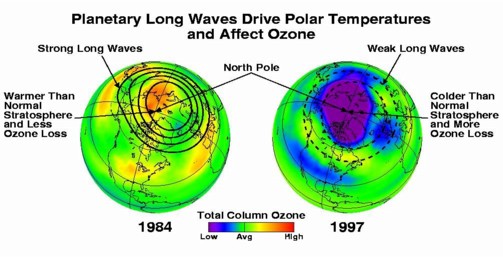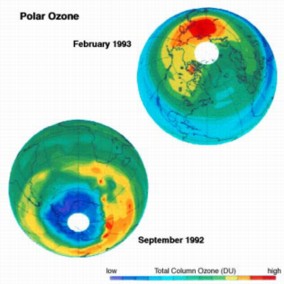|
Huge planet-girdling atmospheric waves suppress
ozone holes over Earth's northern hemisphere.
By Patrick L.Barry and Dr Tony
Phillips
Most of the world's ozone-destroying pollutants
come from the northern half of our planet. Yet Earth's yawning ozone
hole straddles the south pole - not the north.
Why? New research confirms what
scientists have long thought: Giant atmospheric waves spawned by
land features such as the Himalayas damp the formation of a northern
ozone hole and, as a result, Arctic cities remain safe from unwelcome
doses of solar ultraviolet radiation - at least for now. Researchers
caution that climate change could undo the work of those waves and
make Arctic ozone holes more common in the future.
Small ozone holes have in fact formed
over the Arctic before; the spring of 1997 is a recent example.
But such events are the exception rather than the rule. The chemistry
of ozone destruction requires very cold air temperatures in the
stratosphere, and the Arctic stratosphere just isn't as cold as
its Antarctic counterpart.
The north-south difference is an indirect
result of the way land is distributed around Earth - that is, unevenly.
Most of our planet's land and its highest mountains are in the northern
hemisphere.
High mountains and land-sea boundaries
combine to generate vast undulations in the atmosphere called "planetary-scale
waves," or "long waves," which act to heat polar air. Planetary-scale
waves are so large that some of them wrap around the whole Earth!
Unlike water waves, which displace the water up and down, planetary
waves displace air north and south as they travel around our planet.
They form in the troposphere (the lowest part of the atmosphere)
and propagate upward, transferring their energy to the stratosphere.
Stronger planetary waves in the northern
hemisphere warm the Arctic stratosphere and suppress ozone destruction.
Land forms in the southern hemisphere also produce planetary waves,
but they tend to be weaker because there are fewer tall mountain
ranges and more open ocean around Antarctica

In years when
planetary waves (or "long waves") in the Northern Hemisphere
are unusually weak, an ozone hole can form over the Arctic.
Blue and purple indicate regions of low stratospheric ozone.
|
"The Himalayan plateau is a terrific forcing
function for these waves in the north," says Paul Newman, an atmospheric
physicist at NASA's Goddard Space Flight Centre."If you didn't have
the Himalayas, the stratosphere over the Arctic would be much colder
than it is."
Newman was the lead author of a paper
published in September 2001 which presents satellite and meteorological
data linking planetary waves to bursts of warming registered in
the Arctic - a connection that scientists long-ago recognised but
have only now quantified. (His paper appeared in the September 16th
issue of Journal of Geophysical Research - Atmospheres.)
"Typically a wave will warm the polar
region by 5° to 10° C," Newman continued. "A 'warm' polar
stratosphere is typically in the temperature range -73° to -63°
C. Of course, as soon as the wave has dissipated, the polar region
begins to cool down again."

Credit: Lamont Poole, NASA
Dangerous beauty.
Polar
stratospheric clouds (PSCs) are common in Antarctica,
but a rare sight in the Arctic. They form when temperatures
in the stratosphere become extremely cold - below -78° C.
PSCs spell trouble for ozone; tiny ice crystals and droplets
within the clouds provide surfaces where CFCs are converted
into ozone-destroying molecules.
|
Indeed, planetary waves in the northern
hemisphere don't always heat the stratosphere enough to prevent
substantial ozone destruction. In 1997, for example, the waves were
weak because of capricious weather. That triggered a rare springtime
ozone hole over the Arctic.
Scientists are concerned that climate
change could make such times more common. "If our models of Arctic
stratospheric cooling are correct, we would expect lower ozone values
across the Arctic during this century," says Newman.
It so happens that stratospheric cooling
can be a curious result of global warming. Greenhouse gases,
which trap the heat radiating from Earth's surface in the lowest
layer of the atmosphere, reduce the heat that reaches the stratosphere.
In effect, greenhouse gases cool the stratosphere by insulating
it from the warmer Earth below.

Spring is the
season when sunlight can trigger the chemistry of stratospheric
ozone destruction. But Earth's two poles react differently
to the coming of spring. Springtime in Antarctica heralds
a large ozone hole, while springtime in the Arctic (six months
later) often brings above-average ozone concentrations. Global
warming could alter this familiar pattern, though, by chilling
the northern stratosphere and producing an ozone hole there
as well. [more]
|
Climate changes associated with global
warming might also weaken planetary waves - so say some computer
models. The cooling of the stratosphere due to this indirect effect
could be more significant than the cooling caused directly by greenhouse
gases. However, Newman cautions that this result is still very uncertain
because of questions about the fidelity of the computer models.
Another wild card is the changing concentration
of ozone-destroying pollutants. The number of CFC molecules in the
lower atmosphere, for example, peaked in 1994 and have since
declined. Computer simulations show that CFCs in the high stratosphere
could return to pre-1980 levels in 30 to 50 years. Because climate
change occurs on similar time scales, it's difficult to say which
trend would dominate: the cooling of the stratosphere, which would
encourage an Arctic ozone hole, or the decline of CFCs, which would
suppress it.
Perhaps only time will tell if far-northern
cities will continue to enjoy the good fortune of year-round polar
ozone. But many researchers aren't content to wait decades for an
answer. With the aid of Earth-watching satellites and ever-improving
computer climate models, scientists hope to unravel the puzzle of
Arctic ozone before it becomes a problem.
After all, one planetary ozone hole
is more than enough!
|
